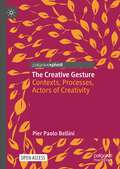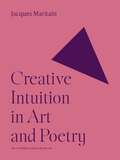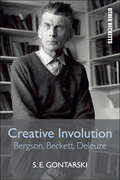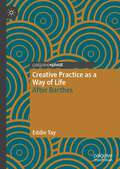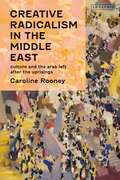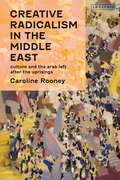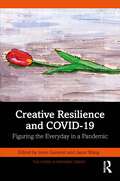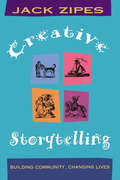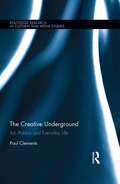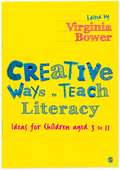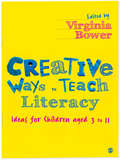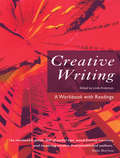- Table View
- List View
The Creative Gesture: Contexts, Processes, Actors of Creativity (Palgrave Studies in Creativity and Culture)
by Pier Paolo BelliniThis open access book offers a concise overview of the theories constructed within the various human sciences around the theme of creativity as a symbolic capacity to link things together: it manifests itself when the individual endowed with a certain type of intelligence encounters cultural and social conditions that enable them to develop that capacity to the maximum, rather than inhibiting it or diverting it to other fields where it is doomed to failure. Even the most intimate of human expressiveness is considered as a result of an active social relationality. Social dimensions of creativity (evaluation, primary socialization, motivation, leadership) and “creative processes” (creative attitude, creative gesture, divergent thinking, problem-solving capacity, interdisciplinary approach, randomness, algorithmic creativity) are also analysed.The book concludes by evaluating the course taken in the light of the relational theory of society: the development of creativity cannot beconceived outside of self-other relations.This book is the result of a translation done with the help of artificial intelligence. The text has subsequently been revised further by a professional copy editor in order to refine the work stylistically.
Creative Intuition in Art and Poetry (The A. W. Mellon Lectures in the Fine Arts #1)
by Jacques MaritainThe classic work on the sublime interplay between the arts and poeticsThis book explores the rich and complex relationship between art and poetry, shedding invaluable light on what makes each art form unique yet wholly interdependent. Jacques Maritain insists on the part played by the intellect as well as the imagination, showing how poetry has its source in the preconceptual activity of the rational mind. As Maritain argues, intellect is not merely logical and conceptual reason. Rather, it carries on an exceedingly more profound and obscure life, one that is revealed to us as we seek to penetrate the hidden recesses of poetic and artistic activity. Incisive and authoritative, this illuminating book is the product of a lifelong reflection on the meaning of artistic expression in all its varied forms.
Creative Involution: Bergson, Beckett, Deleuze (Other Becketts)
by S. E. GontarskiAn original philosophical approach to one of the 20th century’s most important literary figures Creative Involution: Bergson, Beckett Deleuze focuses on a force, on a philosophical trajectory that not only had a profound impact on critical thought of the 20th and now 21st centuries, but on cosmopolitan, contemporary culture more broadly and on artistic experiment and expression in particular. It explores how the work of Samuel Beckett intersects with such preoccupations of time as a "double headed monster," of memory and multiplicity, of being and becoming that continue in an involutionary turn through the work of Gilles Deleuze.   Key Features: Deploys new critical approaches (e.g., a return to Bergson and Bergsonism) Addresses underexplored works in the Beckett canon Presents new critiques of representation and Beckett’s relationship to philosophy Attentive to critical thinking around affect theory and/in literature. S. E. Gontarski is Robert O. Lawton Distinguished Professor of English at Florida State University where he edited the Journal of Beckett Studies from 1992-2008. He currently serves as Co-Editor for the Journal. Among his recent books are: The Beckett Critical Reader: Archives, Theories, and Translations (2012) and The Edinburgh Companion to Samuel Beckett and the Arts (2014), both from Edinburgh University Press, and a second edition of On Beckett: Essays and Criticism from Anthem Press (2012).
Creative Involution: Bergson, Beckett, Deleuze (Other Becketts)
by S. E. GontarskiAn original philosophical approach to one of the 20th century’s most important literary figures Creative Involution: Bergson, Beckett Deleuze focuses on a force, on a philosophical trajectory that not only had a profound impact on critical thought of the 20th and now 21st centuries, but on cosmopolitan, contemporary culture more broadly and on artistic experiment and expression in particular. It explores how the work of Samuel Beckett intersects with such preoccupations of time as a "double headed monster," of memory and multiplicity, of being and becoming that continue in an involutionary turn through the work of Gilles Deleuze.   Key Features: Deploys new critical approaches (e.g., a return to Bergson and Bergsonism) Addresses underexplored works in the Beckett canon Presents new critiques of representation and Beckett’s relationship to philosophy Attentive to critical thinking around affect theory and/in literature. S. E. Gontarski is Robert O. Lawton Distinguished Professor of English at Florida State University where he edited the Journal of Beckett Studies from 1992-2008. He currently serves as Co-Editor for the Journal. Among his recent books are: The Beckett Critical Reader: Archives, Theories, and Translations (2012) and The Edinburgh Companion to Samuel Beckett and the Arts (2014), both from Edinburgh University Press, and a second edition of On Beckett: Essays and Criticism from Anthem Press (2012).
Creative Metaphor, Evaluation, and Emotion in Conversations about Work (Routledge Focus on Applied Linguistics)
by Jeannette Littlemore Sarah Turner Penelope TuckThis book explores the roles played by creative and conventional metaphor in expressing positive and negative evaluation within a particular workplace, drawing on interviews with 31 current and former employees of the British Civil Service. Metaphor is often used to express evaluation but relatively few studies have investigated the ways in which metaphor is used to evaluate personal emotionally charged experiences. The volume explores how metaphor serves a predominantly evaluative function, with creatively used metaphors often more likely than conventional metaphors to perform an evaluative function, particularly when the evaluation is negative or ambiguous. The findings provide a deeper understanding of the relationship between evaluation, creativity, and metaphor. Examples, including military metaphors and family metaphors, show how creativity often comes through subverting the norms of use of a particular metaphor category, or altering the valence from its conventional use. The study elucidates the myriad ways in which people push at the boundaries of linguistic creativity in their efforts to describe the qualitative nature of their experiences. Demonstrating how metaphor can be a powerful tool for the nuanced expression of complex and ambiguous evaluation, this book will appeal to researchers interested in better understanding metaphor, creativity, evaluation, and workplace cultures.
Creative Metaphor, Evaluation, and Emotion in Conversations about Work (Routledge Focus on Applied Linguistics)
by Jeannette Littlemore Sarah Turner Penelope TuckThis book explores the roles played by creative and conventional metaphor in expressing positive and negative evaluation within a particular workplace, drawing on interviews with 31 current and former employees of the British Civil Service. Metaphor is often used to express evaluation but relatively few studies have investigated the ways in which metaphor is used to evaluate personal emotionally charged experiences. The volume explores how metaphor serves a predominantly evaluative function, with creatively used metaphors often more likely than conventional metaphors to perform an evaluative function, particularly when the evaluation is negative or ambiguous. The findings provide a deeper understanding of the relationship between evaluation, creativity, and metaphor. Examples, including military metaphors and family metaphors, show how creativity often comes through subverting the norms of use of a particular metaphor category, or altering the valence from its conventional use. The study elucidates the myriad ways in which people push at the boundaries of linguistic creativity in their efforts to describe the qualitative nature of their experiences. Demonstrating how metaphor can be a powerful tool for the nuanced expression of complex and ambiguous evaluation, this book will appeal to researchers interested in better understanding metaphor, creativity, evaluation, and workplace cultures.
Creative Practice as a Way of Life: After Barthes (Palgrave Studies in Creativity and Culture)
by Eddie TayThis book combines autoethnographic reflections, poetry, and photography with the aim to bridge the gap between creative practice and scholarly research. Drawing on an innovative combination of different forms of knowledge, creative writing and street photographs are presented as means to reflect on the development of knowledge and self-knowledge through a thought-provoking dialogue with Roland Barthes’ post-structuralist work. What does it mean to be a creative practitioner in a world traversed by values of capitalism and artificial intelligence? What does it mean to teach creative practices in such an environment?The urban landscape of Singapore, with the Jewel Changi mall, the Universal Studios, and Little India in the background, is the stage where the capitalist demands of modern city life grapple with the solitary act of writing poetry and taking photographs through the personal experience of the author. Capitalist realism and depression realism entwine with Barthes' notion of vita nova in a mesmerizing phantasmagoria that drags the reader to the bowels and secret pleasures of the creative process.
Creative Radicalism in the Middle East: Culture and the Arab Left after the Uprisings (Written Culture and Identity)
by Sorcha ThomsonAddressing the question of how neoliberal ideology has served to conflate the radical left with extremism, this book examines how the Arab left has asserted itself in the context of authoritarianism and Islamic extremism during and after the Arab uprisings. It examines how the Arab cultural left has offered a critique of the signifying practices of political hegemonies in the region and argues that though creative expression as constituted in the very language of the Arab uprisings, it has put forward its own alternativesUsing a wide array of texts and sources, both Arab and non-Arab, the opening chapters of the book identify how ethical and radical values pertaining to sociality are co-opted by political leaders in the Middle East and turned into jargon. Later chapters outline resistance to this co-option through a poetics of inter-subjectivity that takes structures of feeling into account, ranging from disappointment, despair and distrust, to dignity, solidarity and reconfigured senses of the sacred. In showing how psychological and affective states relate to signifying practices, the book offers an original conceptual framework for differentiating 'radicalization' from the creative radicalism of the Arab avant-garde.
Creative Radicalism in the Middle East: Culture and the Arab Left after the Uprisings (Written Culture and Identity)
by Sorcha ThomsonAddressing the question of how neoliberal ideology has served to conflate the radical left with extremism, this book examines how the Arab left has asserted itself in the context of authoritarianism and Islamic extremism during and after the Arab uprisings. It examines how the Arab cultural left has offered a critique of the signifying practices of political hegemonies in the region and argues that though creative expression as constituted in the very language of the Arab uprisings, it has put forward its own alternativesUsing a wide array of texts and sources, both Arab and non-Arab, the opening chapters of the book identify how ethical and radical values pertaining to sociality are co-opted by political leaders in the Middle East and turned into jargon. Later chapters outline resistance to this co-option through a poetics of inter-subjectivity that takes structures of feeling into account, ranging from disappointment, despair and distrust, to dignity, solidarity and reconfigured senses of the sacred. In showing how psychological and affective states relate to signifying practices, the book offers an original conceptual framework for differentiating 'radicalization' from the creative radicalism of the Arab avant-garde.
Creative research communication: Theory and practice
by Emma Weitkamp Clare WilkinsonAimed at scholars interested in engaging the public with their research and postgraduate students exploring the practical aspects of research communication, this book provides a theoretically grounded introduction to new and emerging approaches to public engagement and research communication. Split into three sections, the reader first explores the historical approaches and current drivers for public engagement with research. Part two explores practical approaches to research engagement, from face-to-face communication in novel settings, such as festivals, through to artistic approaches, before considering new and emerging digital tools and approaches. Each practical chapter is theoretically grounded, exploring issues such as audience, interactivity, and impact. The final section explores ethical considerations in relation to public engagement as well as discussing the way that research communication fits into wider discussions about the impact of research, before concluding with a discussion around disseminating the success (or otherwise) of novel approaches to public engagement to wider groups, including public engagement practitioners.
Creative Resilience and COVID-19: Figuring the Everyday in a Pandemic (The COVID-19 Pandemic Series)
by Irene GammelCreative Resilience and COVID-19 examines arts, culture, and everyday life as a way of navigating through and past COVID-19. Drawing together the voices of international experts and emerging scholars, this volume explores themes of creativity and resilience in relation to the crisis, trauma, cultural alterity, and social change wrought by the pandemic. The cultural, social, and political concerns that have arisen due to COVID-19 are inextricably intertwined with the ways the pandemic has been discussed, represented, and visualized in global media. The essays included in this volume are concerned with how artists, writers, and advocates uncover the hope, plasticity, and empowerment evident in periods of worldwide loss and struggle—factors which are critical to both overcoming the COVID-19 pandemic and fashioning the post-COVID-19 era. Elaborating on concepts of the everyday and the outbreak narrative, Creative Resilience and COVID-19 explores diverse themes including coping with the crisis through digital distractions, diary writing, and sounds; the unequal vulnerabilities of gender, ethnicity, and age; the role of visuality and creativity including comics and community theatre; and the hopeful vision for the future through urban placemaking, nighttime sociability, and cinema. The book fills an important scholarly gap, providing foundational knowledge from the frontlines of the COVID-19 pandemic through a consideration of the arts, humanities, and social sciences. In doing so, Creative Resilience and COVID-19 expands non-medical COVID-19 studies at the intersection of media and communication studies, cultural criticism, and the pandemic.
Creative Resilience and COVID-19: Figuring the Everyday in a Pandemic (The COVID-19 Pandemic Series)
by Jason Wang Irene GammelCreative Resilience and COVID-19 examines arts, culture, and everyday life as a way of navigating through and past COVID-19. Drawing together the voices of international experts and emerging scholars, this volume explores themes of creativity and resilience in relation to the crisis, trauma, cultural alterity, and social change wrought by the pandemic. The cultural, social, and political concerns that have arisen due to COVID-19 are inextricably intertwined with the ways the pandemic has been discussed, represented, and visualized in global media. The essays included in this volume are concerned with how artists, writers, and advocates uncover the hope, plasticity, and empowerment evident in periods of worldwide loss and struggle—factors which are critical to both overcoming the COVID-19 pandemic and fashioning the post-COVID-19 era. Elaborating on concepts of the everyday and the outbreak narrative, Creative Resilience and COVID-19 explores diverse themes including coping with the crisis through digital distractions, diary writing, and sounds; the unequal vulnerabilities of gender, ethnicity, and age; the role of visuality and creativity including comics and community theatre; and the hopeful vision for the future through urban placemaking, nighttime sociability, and cinema. The book fills an important scholarly gap, providing foundational knowledge from the frontlines of the COVID-19 pandemic through a consideration of the arts, humanities, and social sciences. In doing so, Creative Resilience and COVID-19 expands non-medical COVID-19 studies at the intersection of media and communication studies, cultural criticism, and the pandemic.
The Creative Screenwriter: Exercises to Expand Your Craft
by Craig Batty Zara WaldebackThis is a book for aspiring screenwriters who want to establish a powerful writing practice; a manual for teachers and students seeking inspiring exercises to encourage discussion and reflection; and a handbook for professionals wanting to hone their craft and solve specific writing problems. It is a book that will help rekindle the creative spark, remind you why you enjoy writing, and create new ways to help you expertly express the stories you want to tell - and sell!
Creative Screenwriting: Understanding Emotional Structure
by John Howard Christina KallasChristina Kallas argues for and sets out a genuinely original and creative approach to writing for the screen. This textbook aims to excite the imagination, inspiring and dramatizing stories with thematic richness, emotional depth and narrative rhythm. Structured like a screenplay, the book moves through the pre-credit sequence to the epilogue, interweaving theory, practice and case studies. Kallas combines an awareness of the history of dramatic writing with a very practical focus on how to find ideas and develop them. Supported by innovative and inspiring exercises that enable writers to create stories out of emotions and images, this book is challenging, motivating and essential reading for anyone interested in screenwriting.
Creative Storytelling: Building Community/Changing Lives
by Jack ZipesJack Zipes has reinvigorated storytelling as a successful and engaging tool for teachers and professional storytellers. Encouraging storytellers, librarians, and schoolteachers to be active in this magical process, Zipes proposes an interactive storytelling that creates and strengthens a sense of community for students, teachers and parents while extolling storytelling as animation, subversion, and self-discovery.
Creative Storytelling: Building Community/Changing Lives
by Jack ZipesJack Zipes has reinvigorated storytelling as a successful and engaging tool for teachers and professional storytellers. Encouraging storytellers, librarians, and schoolteachers to be active in this magical process, Zipes proposes an interactive storytelling that creates and strengthens a sense of community for students, teachers and parents while extolling storytelling as animation, subversion, and self-discovery.
The Creative Underground: Art, Politics and Everyday Life (Routledge Research in Cultural and Media Studies)
by Paul ClementsPaul Clements champions the creative underground and expressions of difference through visionary avant-garde and resistant ideas. This is represented by an admixture of utopian literature, manifestos and lifestyles which challenge normality and attempt to reinvent society, as practiced for example, by radicals in bohemian enclaves or youth subcultures. He showcases a range of 'art' and participatory cultural practices that are examined sociopolitically and historically, employing key theoretical ideas which highlight their contribution to aesthetic thinking, political ideology, and public discourse. A reevaluation of the arts and progressive modernism can reinvigorate culture through active leisure and post-work possibilities beyond materialism and its constraints, thereby presenting alternatives to established understandings and everyday cultural processes. The book teases out the difficult relationship between the individual, culture and society especially in relation to autonomy and marginality, while arguing that the creative underground is crucial for a better world, as it offers enchantment, vitality and hope.
The Creative Underground: Art, Politics and Everyday Life (Routledge Research in Cultural and Media Studies)
by Paul ClementsPaul Clements champions the creative underground and expressions of difference through visionary avant-garde and resistant ideas. This is represented by an admixture of utopian literature, manifestos and lifestyles which challenge normality and attempt to reinvent society, as practiced for example, by radicals in bohemian enclaves or youth subcultures. He showcases a range of 'art' and participatory cultural practices that are examined sociopolitically and historically, employing key theoretical ideas which highlight their contribution to aesthetic thinking, political ideology, and public discourse. A reevaluation of the arts and progressive modernism can reinvigorate culture through active leisure and post-work possibilities beyond materialism and its constraints, thereby presenting alternatives to established understandings and everyday cultural processes. The book teases out the difficult relationship between the individual, culture and society especially in relation to autonomy and marginality, while arguing that the creative underground is crucial for a better world, as it offers enchantment, vitality and hope.
Creative Ways to Teach Literacy: Ideas for Children aged 3 to 11 (PDF)
by Virginia BowerShortlisted for the UKLA Academic Book Award 2013! Covering the essential areas of practice, this book suggests ways to make your literacy teaching as creative and engaging as possible. Children get the most out of their learning when it is exciting, and this book offers great ideas for classroom practice, whilst making careful links to research. Sections advise on teaching narrative, poetry and non-fiction, and each chapter contains case studies and ideas to try out in practice. The authors cover a broad range of topics, including: - exploring traditional tales - writing from experience - using playground games as a foundation for literacy - performing poetry. Written for teachers working with children aged 3-11 years, this book gives you the opportunity to develop children's literacy in enjoyable and interesting ways.
Creative Ways to Teach Literacy: Ideas for Children aged 3 to 11
by Virginia BowerShortlisted for the UKLA Academic Book Award 2013! Covering the essential areas of practice, this book suggests ways to make your literacy teaching as creative and engaging as possible. Children get the most out of their learning when it is exciting, and this book offers great ideas for classroom practice, whilst making careful links to research. Sections advise on teaching narrative, poetry and non-fiction, and each chapter contains case studies and ideas to try out in practice. The authors cover a broad range of topics, including: - exploring traditional tales - writing from experience - using playground games as a foundation for literacy - performing poetry. Written for teachers working with children aged 3-11 years, this book gives you the opportunity to develop children's literacy in enjoyable and interesting ways.
The Creative Writer's Workshop, 5th Edition: A Sourcebook for Releasing Your Creativity and Finding Your True Writer's Voice
by Cathy BirchThis book aims to get you writing and keep you writing - and help you enjoy your writing to the full. It will show you how to free your own unique voice and create original, individual work. It is packed with exercises, visualisation techniques, flow charts, dream-work and word webs that will enable you to explore the treasures of your subconscious, revisit your childhood world of games and make believe, and bring back what you find. Then it shows you how to harness that creativity in developing your characters, settings, plot and dialogue. Additional exercises focus on sustaining your own motivation, providing the perfect setting in which to develop your writing. This book will help you at every stage. Use it to rediscover your love of words and the spontaneity in your writing. Find your voice and become the writer you were meant to be.Contents: 1. Writing as a Way of Life; 2. Tuning In; 3. Discovering the Plot; 4. Developing Atmosphere, Pace and Mood; 5. Working with Beginnings and Endings; 6. Surprise Yourself; 7. Working With Your Dreams; 8. Recycling; 9. Crafting Your Work; 10. Editing Your Work; Glossary; References; Further reading; Useful addresses and websites; Index.
Creative Writing: A Workbook With Readings (PDF)
by Linda AndersonCreative Writing is a complete writing course that will jump-start your writing and guide you through your first steps towards publication. Suitable for use by students, tutors, writers' groups or writers working alone, this book offers: a practical and inspiring section on the creative process, showing you how to stimulate your creativity and use your memory and experience in inventive ways in-depth coverage of the most popular forms of writing, in extended sections on fiction,poetry and life writing, including biography and autobiography, giving you practice in all three forms so that you might discover and develop your particular strengths a sensible, up-to-date guide to going public, to help you to edit your work to a professional standard and to identify and approach suitable publishers a distinctive collection of exciting exercises, spread throughout the workbook to spark your imagination and increase your technical flexibility and control a substantial array of illuminating readings, bringing together extracts from contemporary and classic writings in order to demonstrate a range of techniques that you can use or adapt in your own work. Creative Writing: A Workbook with Readingspresents a unique opportunity to benefit from the advice and experience of a team of published authors who have also taught successful writing courses at a wide range of institutions, helping large numbers of new writers to develop their talents as well as their abilities to evaluate and polish their work to professional standards. These institutions include Lancaster University and the University of East Anglia, renowned as consistent producers of published writers. 0415372429 0415372437
Creative Writing: A Workbook With Readings
by Linda AndersonCreative Writing is a complete writing course that will jump-start your writing and guide you through your first steps towards publication. Suitable for use by students, tutors, writers' groups or writers working alone, this book offers: a practical and inspiring section on the creative process, showing you how to stimulate your creativity and use your memory and experience in inventive ways in-depth coverage of the most popular forms of writing, in extended sections on fiction,poetry and life writing, including biography and autobiography, giving you practice in all three forms so that you might discover and develop your particular strengths a sensible, up-to-date guide to going public, to help you to edit your work to a professional standard and to identify and approach suitable publishers a distinctive collection of exciting exercises, spread throughout the workbook to spark your imagination and increase your technical flexibility and control a substantial array of illuminating readings, bringing together extracts from contemporary and classic writings in order to demonstrate a range of techniques that you can use or adapt in your own work. Creative Writing: A Workbook with Readingspresents a unique opportunity to benefit from the advice and experience of a team of published authors who have also taught successful writing courses at a wide range of institutions, helping large numbers of new writers to develop their talents as well as their abilities to evaluate and polish their work to professional standards. These institutions include Lancaster University and the University of East Anglia, renowned as consistent producers of published writers. 0415372429 0415372437
Creative Writing: A Workbook with Readings
by Linda AndersonCreative Writing is a complete writing course that will jump-start your writing and guide you through your first steps towards publication. Suitable for use by students, tutors, writers’ groups or writers working alone, this book offers: a practical and inspiring section on the creative process, showing you how to stimulate your creativity and use your memory and experience in inventive ways in-depth coverage of the most popular forms of writing, in extended sections on fiction, poetry and life writing, including biography and autobiography, giving you practice in all three forms so that you might discover and develop your particular strengths a sensible, up-to-date guide to going public, to help you to edit your work to a professional standard and to identify and approach suitable publishers a distinctive collection of exciting exercises, spread throughout the workbook to spark your imagination and increase your technical flexibility and control a substantial array of illuminating readings, bringing together extracts from contemporary and classic writings in order to demonstrate a range of techniques that you can use or adapt in your own work. Creative Writing: A Workbook with Readings presents a unique opportunity to benefit from the advice and experience of a team of published authors who have also taught successful writing courses at a wide range of institutions, helping large numbers of new writers to develop their talents as well as their abilities to evaluate and polish their work to professional standards. These institutions include Lancaster University and the University of East Anglia, renowned as consistent producers of published writers.
Creative Writing: A Workbook with Readings
by Linda AndersonCreative Writing is a complete writing course that will jump-start your writing and guide you through your first steps towards publication. Suitable for use by students, tutors, writers’ groups or writers working alone, this book offers: a practical and inspiring section on the creative process, showing you how to stimulate your creativity and use your memory and experience in inventive ways in-depth coverage of the most popular forms of writing, in extended sections on fiction, poetry and life writing, including biography and autobiography, giving you practice in all three forms so that you might discover and develop your particular strengths a sensible, up-to-date guide to going public, to help you to edit your work to a professional standard and to identify and approach suitable publishers a distinctive collection of exciting exercises, spread throughout the workbook to spark your imagination and increase your technical flexibility and control a substantial array of illuminating readings, bringing together extracts from contemporary and classic writings in order to demonstrate a range of techniques that you can use or adapt in your own work. Creative Writing: A Workbook with Readings presents a unique opportunity to benefit from the advice and experience of a team of published authors who have also taught successful writing courses at a wide range of institutions, helping large numbers of new writers to develop their talents as well as their abilities to evaluate and polish their work to professional standards. These institutions include Lancaster University and the University of East Anglia, renowned as consistent producers of published writers.
